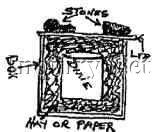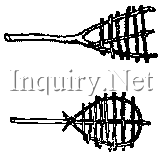Primitive Cooking Techniques
Grilling: Sear meat by thrusting it into flame to seal in the juices, then cook slowly over bright coals of hardwoods. If a pan is used it should be very hot before meat is put in. Turn frequently. Add salt later to make blood tun.
Frying: Tendency to fry everything is bad for digestion. Deep frying is best. Fat should be smoking hot before meat is immersed. This seals in juices and is less greasy.
Pot Roast: Put bones or scrubbed stones in bottom of dixie (a large cooking pot with a volume of 2-5 gallons [10 to 20 liters] and usually made of cast iron. Typically one could cook a chicken in a dixie) for roast to rest on with good supply of fat. As soon as fat boils put in roast. When it browns on one side, turn it to seal in the juices. After this, boiling water must be added to depth of 2 inches. Cook steadily, turning and basting, allowing 20 minutes for each pound plus 20 minutes. Two small roasts will cook more quickly than one large one.
Greens: Remove coarse leaves, wash thoroughly, cut up and put into boiling water (not too much) to which salt has been added. Boil for about 20 minutes. (The alternative method of cooking in very small quantities of water with lid on pot is perhaps better, but necessitates constant attention to prevent drying up and consequent damage to dixie.
To avoid burning: Stand cooking pot inside larger pot containing small quantity of water, especially useful for porridge, custard, cocoa, etc.

Haybox Cooking: To make a haybox, line tea chest with newspaper to insulate and cover the bottom with tightly packed hay to a depth of 6 inches. Place in cooking pot and pack around tightly with hay, then withdraw pot. Have extra hay and newspaper available. The haybox is now ready for use. Bring cooking pot to the boil and place in the box while still boiling, pack hay over it tightly, cover with newspaper and replace lid of box with a weight to compress it. Specially useful for foods which require slow cooking, porridge, stew, etc.
Stewing: Dust meat with flour and fry first to sear with a little fat, then add cold water a little at a time. Stir meat and bring to boil, then add ingredients. Replace lid and simmer gently for as long as possible. "A stew boiled is a stew spoiled".

Baking Twist and damper,
using reflector fire made from logs.
Roasting: By direct heat using spit and reflector. Hardwood fire against back logs with meat suspended on cord in front, fat bacon on top helps baste; catch fat in pan.
Alternatively, roast under bowl or oil drum oven. When using bowl, build hot fire to heat ground first, scrape away hot coals and place meat on plate with bowl inverted over it, then rebuild the fire around the bowl. Oil drum oven should have false bottom to keep meat from contact with wall.

Biscuit Tin Oven:
Use lid for door.
Baking: Use bowl, Dutch oven, biscuit tin or oil drum oven. To use Dutch oven, prepare fire-bed of mixed quick and slow burning woods, build shell of clay over it, leaving front open, and set fire to fire-bed.
Measuring Quantities
At home it's an easy matter to measure; in camp you won't have elaborate equipment, so here are a few tips:
1 oz. flour, cocoa, custard powder; = a well heaped tablespoon.
1 oz. sugar, rice, butter, fat = a flat tablespoon.
1/2 pint liquid = a normal camp mug full.
1 pint camp mug, when lightly filled, holds approximately:
| 5 oz Flour | |
| 8 oz Granulated sugar | |
| 2 1/2 oz Breadcrumbs | |
| 4 oz Grated cheese | |
| 7 oz Rice | |
| 6 oz Sultanas |

Circular--Good; D Shape--Bad
A circular can with rounded comers is best: no corners for food to stick and burn -- easier to stir and clean.
The real stumbling block at camp is: Hot Water. Always have a billy (a small cooking pot about 1.5 to 4 quarts, and made of a jam tin. Traditionally a billy would be used for boiling water for soup, tea or coffee) or dixie of water on the fire for hot water, whenever you use the water out of the billy, remember to fill it up. Plenty of hot water in camp means half your battle is over
LIQUIDS
Hot drinks are necessary in camp, especially at the beginning and end of day. Left to themselves, Scouts will often neglect these as they do not realize their importance.
Drinks often badly prepared - regarded as simple, so little care taken. Scouts have a habit of preparing rest of meal before thought to drink, with result that meal is over before water has come to boil. They should be taught to put water on fire in early stages of preparation
Tea: Keep special billy for tea stage. Water must be boiling briskly when tea is added, after which the billy must removed immediately from the fire. Tea leaves must be allowed to stew. Tea bags are useful but must be kept clean; (not hung on a rail of camp kitchen throughout the day). A teapot is an invaluable article of Patrol equipment.
Coffee: Useful change, but more expensive. Must not be too strong. Nescafe or similar preparations most useful in camp.
Cocoa: Mix a paste with cold water, then boil up for short time. Keep stirred.
Soup: Very valuable, especially on cold days. Encourage Patrols to keep their own stock pot with bones and to experiment with wild herbs, nettle shoots, etc.
Lemonade: Made from real lemons, better than commercial variety.
Cold Milk: Should be sipped, not gulped.
BACKWOODS AND INDIVIDUAL COOKING
Backwoods cooking has strong appeal and is an excellent Patrol activity, working in pairs. Need not be wasteful if done properly, but is generally a slow process--more time needed to prepare meal than by orthodox methods. Not more than one meal should be attempted by this method in any one day.
Firing is of vented importance. Scouts should be trained to differentiate between hard and soft wood fires (this ties up with woodcraft and tree recognition).
Breadmaking: Mix flour, salt, and water to thick dough without handling too much. To make twist, peel green stick not less than 1" diameter, bake in fire, then twist spiral of dough about 1/2" diameter? round it and bake slowly over red embers. Greenstick should not be of bitter or poisonous wood (avoid poplar, elder, etc.).
To make Australian Damper, wrap in green leaves, scrape away red embers and place on ground, then build fire over it. Dampers in aluminum foil are made in the same way and are excellent!

Greenstick Broiler
Greenstick Broiler: Green twigs are woven across a three pronged stick to make a grill. Meat is seared in the flame, then placed on the grill and broiled slowly over red coals. Add salt to bring out the juices.
Oat Cakes: Mix oats with flour and make into a dry paste with milk. Bake as for Australian Damper.
Potatoes: Bake in wet leaves or paper, or very thin shell of clay or in aluminum foil.
Kabobs: Alternate thin slices of apple, bacon, potato, spiked on a thin green stick and roasted slowly over hardwoods. (Potato generally takes longest to cook).
Flab: Wash and pin out on a flat board. Bake slowly on reflector principle.
Eggs: Crack egg and put in shell of clay about 1/2 inch thick, bake in red embers. To make spud-eggs, cut potato across short axis, hollow out both halves, break egg into it, replace top and spike in place with sharpened match stick, bake in embers for about 15 minutes.
Foil Cooking: Excellent results can be obtained. American Explorer Scouts prepare their "pressure packs" before leaving for hike and after cooking open the foil and use as dinner plate.
Method: Make envelope of foil sealed with a double fold down three edges, cut meat, vegetables, etc., into cubes, and put in envelope with seasoning and teaspoon of water or fat (this is essential). Seal top of envelope and place in fire, clear of flames (which will cause foil to granulate). Potatoes, apples, and bread can also be cooked by the same method.
Traditional
Training Handbook
©2003 Baden-Powell Scouts Association
